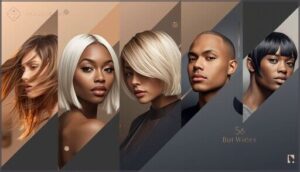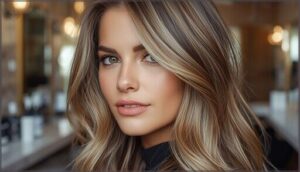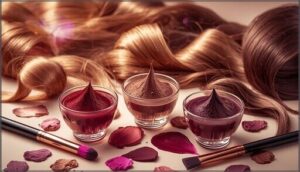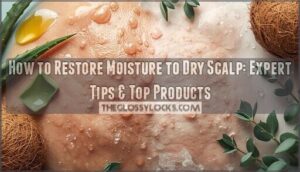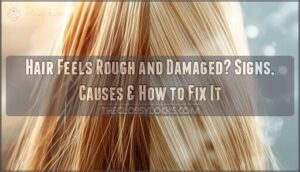This site is supported by our readers. We may earn a commission, at no cost to you, if you purchase through links.
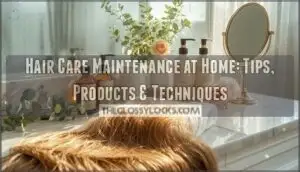 Your bathroom mirror doesn’t lie—those split ends, that dullness, the frizz that refuses to cooperate. Salon visits promise transformation, but the real work happens in the days between appointments.
Your bathroom mirror doesn’t lie—those split ends, that dullness, the frizz that refuses to cooperate. Salon visits promise transformation, but the real work happens in the days between appointments.
Hair care maintenance at home determines whether your strands thrive or simply survive. Most people unknowingly damage their hair daily through rushed routines and wrong products.
The difference between healthy, vibrant hair and brittle, lifeless strands often comes down to understanding a few fundamental techniques. Master these basics, and you’ll spend less time fixing problems and more time enjoying hair that actually behaves.
Table Of Contents
- Key Takeaways
- Essential Steps for At-Home Hair Care
- Building a Personalized Hair Care Routine
- Top 6 At-Home Hair Care Products
- Expert Tips for Healthy, Stylish Hair
- Trending Hairstyles and Hair Color Ideas
- Frequently Asked Questions (FAQs)
- How can I maintain my hair at home?
- What should a basic hair care routine include?
- What are 3 do’s and don’ts or hair care?
- How do I make my hair healthy again at home?
- How often should I change my pillowcase?
- What water temperature is best for washing hair?
- Can diet affect my hairs health and growth?
- Should I brush wet or dry hair first?
- How do I protect hair while sleeping?
- Conclusion
Key Takeaways
- Your daily habits matter more than occasional salon visits—proper shampooing technique (focusing on the scalp), conditioning only mid-shaft down, and switching to microfiber towels prevents the friction and damage that causes breakage, frizz, and split ends.
- Weekly deep conditioning and scalp oil massage rebuild your hair’s protein structure and stimulate growth at the roots, while regular trims every 6-12 weeks stop split ends from traveling up the hair shaft like a run in stockings.
- Heat styling tools should never exceed 300-350°F for most hair types, and air drying your hair three times weekly dramatically reduces cumulative heat damage that weakens strands over time.
- Identifying your specific hair type (texture, porosity, curl pattern) and adjusting your routine seasonally ensures products actually work for your hair instead of against it, eliminating wasted money on wrong formulas.
Essential Steps for At-Home Hair Care
Your hair care routine at home doesn’t need to be complicated to get salon-quality results. The key is mastering a few essential steps that work together to keep your hair healthy, strong, and looking its best.
Here’s what you need to focus on to build a solid foundation for your at-home maintenance.
Shampooing and Conditioning Correctly
Most people think shampooing is foolproof, but the truth is, you’re probably doing it wrong—and that’s why your hair won’t cooperate. Proper shampoo techniques protect your hair’s pH balance and moisture levels, while conditioner tips help you build a solid hair care routine for lasting hair health.
- Focus shampoo on your scalp, not your ends
- Rinse with cool water to seal the cuticle
- Apply conditioner from mid-shaft down only
- Understand sulfate effects on your hair type
Deep Conditioning and Hair Masks
Your regular shampoo and conditioner aren’t enough to repair damage or restore what heat styling and color treatments strip away—that’s where deep conditioning and hair masks come in. These intensive moisture treatments rebuild your hair’s protein structure and lock in hydration. Apply once weekly for three to five minutes, focusing on damaged areas. Choose masks based on your specific hair needs.
| Hair Concern | Key Mask Ingredients | Hair Mask Benefits |
|---|---|---|
| Dry, brittle hair | Shea butter, argan oil | Restores moisture balance |
| Color-treated hair | Keratin, amino acids | Prevents fading, adds shine |
| Heat damage | Proteins, ceramides | Repairs broken bonds |
| Frizz control | Coconut oil, glycerin | Smooths cuticle layer |
Deep conditioning tips: Section your hair for even distribution, use a shower cap to trap heat, and rinse thoroughly to prevent buildup.
Scalp Care and Oil Massage
Healthy hair starts at the roots, and if you’re skipping scalp care, you’re missing the foundation of everything you just worked to repair. A weekly scalp massage with hair oil stimulates hair follicles, boosts circulation, and removes buildup that blocks growth.
Massage techniques for scalp health:
- Warm your oil between palms before applying
- Use fingertips in circular motions, never nails
- Focus on areas with tension or dryness
- Massage for five to ten minutes minimum
- Leave oil in for thirty minutes before shampooing
Oil benefits extend beyond moisture—they balance sebum production and strengthen hair from the root.
Proper Drying Techniques
How you dry your hair matters just as much as what you put in it—rough towel rubbing causes friction that roughs up the cuticle and leads to breakage before you even pick up a brush. Switch to microfiber towels and use gentle blotting motions instead. Turban wrapping reduces tension while your hair dries.
Air drying a few times weekly protects your strands from heat damage. When you must blow-dry, attach a diffuser and keep the heat setting low to preserve your hair care routine results.
Detangling and Brushing Best Practices
Rushing through detangling tears more strands than you think—the key is working through knots patiently from the ends up instead of yanking a brush from root to tip. Wide-tooth combs work best on wet hair, while boar bristle brushes distribute natural oils through dry strands.
Match your detangling tools to your hair texture—fine hair needs softer bristles than thick, coarse types.
Building a Personalized Hair Care Routine
Your hair isn’t one-size-fits-all, and neither should your routine be. Building a tailored approach means understanding what your hair actually needs and when it needs it.
Here’s how to create a routine that works with your hair, not against it.
Identifying Your Hair Type and Needs
Think of your hair as unique as your fingerprint—no two heads are exactly alike. Before you build an effective Hair Care Routine, you need to understand what you’re working with. Here’s what to assess:
- Curl Patterns – Type 1 (straight) to Type 4 (coily) determines styling needs
- Hair Texture – Fine, medium, or coarse affects moisture retention
- Hair Porosity – How your cuticle absorbs and holds hydration
- Scalp Conditions – Oily, dry, or balanced impacts product choices
- Ethnic Influences – Type 4 hair, common in those of African descent, needs specialized care
Understanding these factors helps you select products that actually work for your Curly Hair or any texture, giving you real Hair Care Tips that deliver results. To better understand your hair, learning about curl type classifications can provide valuable insights.
Frequency of Washing and Treatments
Your Washing Frequency directly impacts Scalp Health and determines how well your Hair Care Routine works. Fine hair needs washing every one to two days, while coarse textures can go two to four days between washes. Curly and coily types thrive on one to three washes weekly using sulfate-free formulas.
Deep Conditioning should happen weekly for most hair types, but damaged strands benefit from two to three sessions. Watch for Product Buildup—use clarifying shampoo monthly to keep your Hair Maintenance effective and prevent that weighed-down feeling. Regular use of a hair care product can help maintain the health and appearance of your hair.
Incorporating Heat Protection
Every time you apply heat to your hair—whether it’s a blow dryer, flat iron, or curling wand—you risk breaking down the protein structure that keeps strands strong and elastic. Thermal Protection creates a barrier between Styling Tools and your hair, preventing Heat Damage before it starts.
Apply Hair Serum or spray before Heat Styling:
- Work through damp hair before blow-drying
- Reapply on dry sections before flat irons
- Choose formulas with silicones or ceramides
- Never exceed 350°F on damaged hair
- Let Hair Protection products dry completely
These Hair Care Products make Hair Styling Techniques safer and more effective.
Regular Trims and Split End Prevention
Split ends don’t heal on their own—once the protective cuticle splits, the damage travels upward like a run in stockings, making regular trims your only real defense against frayed, weakened hair. Schedule Salon Maintenance every six to twelve weeks based on your Hair Health and Maintenance needs. This Hair Treatment approach prevents Hair Breakage and aids Frizz Prevention while keeping your Hair Care Routine effective.
| Hair Condition | Trim Frequency | Why It Matters |
|---|---|---|
| Healthy, minimal damage | Every 10-12 weeks | Maintains shape and prevents future splits |
| Color-treated or heat-styled | Every 6-8 weeks | Removes chemical and thermal damage quickly |
| Curly or textured hair | Every 8-10 weeks | Controls frizz and preserves curl definition |
| Growing out a cut | Every 8-12 weeks | Balances length goals with Split End Repair |
Between appointments, use Hair Care Tips and Tricks like sealing ends with oil to slow breakdown.
Adjusting for Seasonal Changes
Your hair doesn’t know what month it is, but it definitely feels the difference—winter’s dry indoor heat, summer’s humidity, and fall’s crisp air all demand their own adjustments to keep your strands balanced and strong.
Switch to Humidity Control formulas during Summer Protection months, add heavier Winter Care masks when heating systems strip moisture, and refresh your Hair Care Routine with clarifying AtHome Hair Care Products each Autumn Revival to reset your Hair Health and Maintenance strategy.
Top 6 At-Home Hair Care Products
The right products make all the difference when you’re maintaining your hair at home. Professional-grade formulas target specific concerns like oiliness, color protection, dryness, and damage repair.
Here are six products that deliver salon-quality results without the salon price tag.
1. clarify shampoo for oily hair
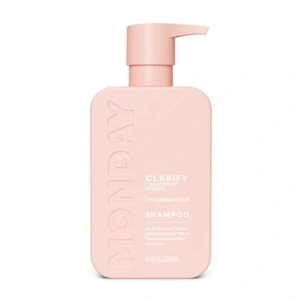
Oily hair solutions start with understanding what buildup really does to your scalp. A clarify shampoo removes up to 100% of excess sebum, product residue, and environmental grime that weighs hair down.
For oily hair types, dermatologists recommend using it once every 1-2 weeks to prevent over-stripping natural oils. Look for formulas with salicylic acid or glycolic acid for deeper scalp balance without harsh sulfates.
Monday Haircare’s Clarify Shampoo offers oil control methods with grapefruit extract and vitamin E—perfect for invigorating your hair care routine between regular washes. Proper use reduces the perception of greasy hair by up to 85%.
Best For: People with oily hair dealing with product buildup, excess sebum, or scalp congestion who want a gentle deep-cleansing solution without harsh sulfates.
- Removes up to 100% of residue and oil buildup while being free of SLS and parabens, making it gentler than traditional clarifying shampoos
- Contains nourishing ingredients like grapefruit extract, vitamin E, and coconut oil that balance the scalp without over-stripping natural oils
- Works for color-treated hair and is dermatologically tested, pH balanced, and cruelty-free (Leaping Bunny approved)
- Some users report it doesn’t clean their scalp thoroughly enough, suggesting effectiveness varies by individual hair type
- The bottle size may seem small for the price point, making it less economical for frequent users
- Packaging looks similar across Monday Haircare products, which can lead to confusion when grabbing the right bottle
2. Purple conditioner for blonde hair
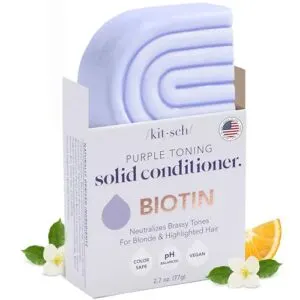
Blonde haircare takes precision, especially when yellow tones creep in between salon visits. Purple toning conditioners use violet pigments to neutralize brassiness—they work best on high hair porosity found in bleached or lightened strands.
Kitsch’s Purple Toning Solid Conditioner strengthens with biotin while depositing color correction during your hair care routine. Apply it 2-5 minutes weekly for cooler, brighter results. Over 70% of users see tonal shifts within seven days.
Pair it with purple shampoo for vigorous hair maintenance and exceptional toning products performance.
Best For: Blonde, grey, or color-treated hair needing an eco-friendly solution to neutralize yellow and brassy tones while strengthening strands.
- Neutralizes unwanted yellow tones effectively with biotin-enriched formula that strengthens and adds shine
- Eco-friendly solid bar format reduces plastic waste and is travel-friendly
- Clean formula free of parabens, phthalates, silicones, sulfates, and artificial fragrances
- May melt quickly with hot water and be used up faster than expected
- Can break into small pieces near end of life and requires dry storage between uses
- Some users find the scent unappealing and application awkward compared to traditional conditioners
3. Redken Moisture Restore Hair Treatment
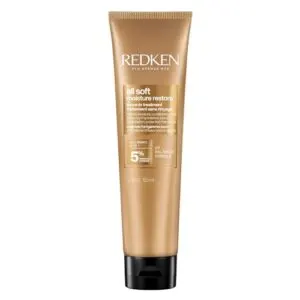
Dry, damaged hair needs more than surface conditioning—it requires moisture that penetrates deep into the hair fiber. Redken All Soft Moisture Restore Leave-In Treatment delivers 72 hours of hydration with hyaluronic acid and a 5% moisture complex containing argan oil and soy protein.
This lightweight formula offers heat protection up to 450°F while smoothing frizz for 24 hours. Apply a dime-sized amount to towel-dried hair before styling.
Clinical tests show 43% greater hydration and 90% easier detangling on bleached strands. It’s essential for maintaining hair restoration between salon visits.
Best For: People with dry, damaged, or chemically treated hair who need deep hydration and heat protection without weighing hair down.
- Delivers 72 hours of moisture with hyaluronic acid and argan oil, plus clinical results showing 43% greater hydration and 90% easier detangling
- Protects hair up to 450°F while taming frizz for 24 hours, making it versatile for both air drying and heat styling
- Lightweight, paraben-free formula won’t cause greasiness or buildup, even on fine hair
- May not suit very oily hair types due to its rich moisturizing formula
- Requires consistent use and proper application technique to see optimal results
- Won’t completely eliminate frizz in extremely humid conditions despite 24-hour protection claims
4. Hyaluron Plump Hydrating Shampoo Care
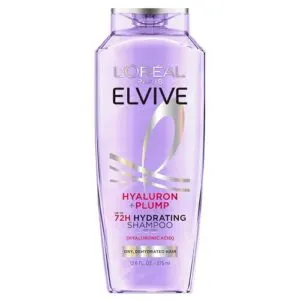
While leave-in treatments repair damage, the right shampoo prevents it. L’Oréal Paris Elvive Hyaluron Plump Hydrating Shampoo uses hyaluronic acid to bind water up to 1,000 times its volume, delivering intense moisture retention for up to 72 hours.
This Hair Care Product nourishes scalp health while removing buildup without stripping natural oils. The paraben-free formula provides 10x more hair hydration than standard shampoos, improving hair health with measurable results—91% of users report softer texture.
It’s a foundational Hair Care Routine step that transforms dry strands through science-backed shampoo ingredients, not empty promises.
Best For: People with dry, dehydrated, or damaged hair who need long-lasting moisture and a gentle, paraben-free formula that works across all hair types.
- Delivers up to 72 hours of hydration with hyaluronic acid that binds 1,000 times its volume in water, making hair noticeably softer and bouncier after one use
- Works for all hair types—color-treated, curly, bleached—and improves scalp health while removing buildup without stripping natural oils
- Eco-friendly packaging uses 100% recyclable materials with 27% less plastic, and the formula is free from parabens and harsh sulfates
- May be too heavy for fine or oily hair, potentially causing greasiness or weigh-down
- The scent (berries, cherry blossom, vanilla, sandalwood) might be overpowering for some users
- Results can vary—some people with very dry or damaged hair may not see the same level of moisture retention as claimed
5. strengthening shampoo for damaged hair
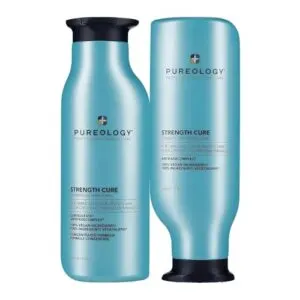
Damaged strands need more than moisture—they need Hair Repair at the molecular level. Strengthening Shampoo for damaged hair uses hydrolyzed proteins and biotin to rebuild weakened keratin bonds, delivering measurable Breakage Reduction.
Formulas with wheat protein and castor oil create a protective barrier that improves Hair Fortification with every wash. Clinical testing shows a 34% decrease in breakage after one use, proving these Shampoo Ingredients work fast.
For chemically treated hair, this Shampoo becomes your first line of Damage Prevention, restoring elasticity and reducing combing force while supporting long-term Hair Health through consistent Hair Care Routine integration.
Best For: Anyone with damaged, chemically treated, or breakage-prone hair who wants to rebuild strength and reduce breakage with protein-rich formulas.
- Clinically proven to reduce breakage by up to 34% after just one use, with visible improvements in strength and manageability within two weeks
- Contains biotin and hydrolyzed proteins that bind to damaged keratin, creating a protective barrier while improving elasticity and reducing combing force
- Works for all hair types and is particularly effective for color-treated or chemically processed hair, with users reporting less frizz and fewer styling products needed
- Results require consistent use over 4-8 weeks to see maximum benefits like improved shine, volume, and split end reduction
- Strengthening effects are temporary and wash out, meaning you need to reapply regularly to maintain hair improvements
- Premium formulas like Pureology can be expensive at $74, and hair may adapt quickly, requiring rotation with other products
6. Biolage Strength Recovery Hair Care
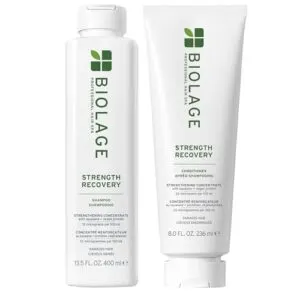
When chemical damage threatens Hair Health, Biolage Strength Recovery delivers targeted Damage Repair through protein-enriched formulas. This system reduces Hair Breakage by 66% while promoting Strength Restoration at the cuticle layer.
The cream-based shampoo and conditioner work together to Hair Fortify weakened strands, while the spray treatment provides continuous Scalp Nourishment between washes.
Integrate this trio into your Hair Care Routine for measurable improvements in elasticity and resilience—essential Hair Maintenance that transforms brittle hair into fortified, manageable locks worth the investment in quality Hair Care Products.
Best For: People with chemically damaged, weak, or brittle hair who need intensive repair and are willing to invest in a higher-priced strengthening system.
- Reduces breakage by 66% and makes hair 3X stronger after one use, delivering measurable results for damaged strands.
- Three-product system (shampoo, conditioner, spray) works together to repair, moisturize, and continuously nourish hair between washes.
- Gentle, non-stripping cream formula that leaves hair soft, smooth, and manageable without harsh ingredients.
- Higher price point at $48 compared to drugstore alternatives, which may not fit all budgets.
- Requires consistent, ongoing use to maintain results—not a one-and-done fix for damaged hair.
- Not specifically formulated for color-treated or curly hair types, limiting its versatility for certain hair concerns.
Expert Tips for Healthy, Stylish Hair
You’ve got the products down—now it’s time to fine-tune your technique. These expert-backed strategies will help you protect your hair from damage while keeping it healthy and looking its best.
Let’s walk through four game-changing habits that make all the difference.
Investing in a Quality Hair Towel
The difference between a regular bathroom towel and a microfiber hair towel isn’t just about luxury—it’s about protecting your hair from unnecessary damage every single day. Traditional cotton towels create friction that roughens your hair cuticle and causes breakage.
Microfiber hair care products offer enhanced hair absorbency and quick dryness without the harsh rubbing. This gentle drying method reduces frizz and keeps your hair maintenance routine damage-free.
Turning Down Hot Tool Temperatures
Most people don’t realize that cranking your flat iron to 450°F is like taking a blowtorch to silk—you’re cooking your hair, not styling it. Heat damage prevention starts with tool temperature control and understanding what your hair actually needs.
Follow these thermal styling safety rules for better hair health:
- Fine or color-treated hair: 250-300°F maximum
- Normal or wavy hair: 300-350°F works best
- Thick or coarse hair: 350-380°F manages the texture
- Always use heat setting management with a protectant first
This simple shift in your hair care routine prevents hair burn reduction and keeps your hair styling tips damage-free.
Sectioning Hair for Even Product Distribution
You can’t evenly coat every strand when you’re dumping product on top of your head like ketchup on fries—sectioning is the difference between patchy coverage and professional results.
Divide your hair texture into four to six hair partition zones using clips. Apply hair care products methodically to each section, working from roots to ends.
This even distribution technique ensures your hair care routine delivers consistent haircare and styling results every time.
Air Drying Vs. Heat Styling
Heat damage is cumulative—every blow-dry session, flat iron pass, and curling wand twirl adds up over time, making air drying your hair’s best friend for long-term health. Let your hair texture dry naturally three times weekly to minimize heat damage from styling tools.
Heat damage accumulates with every styling session, making air drying your hair’s strongest defense for long-term health
If you must use heat for haircare and styling, apply a thermal protectant and lower tool temperatures. This low-maintenance hair styling approach protects your strands while keeping your hair care routine sustainable.
Trending Hairstyles and Hair Color Ideas
Staying on top of trends doesn’t mean sacrificing what works for your hair. The right cut and color can simplify your routine while keeping you looking current.
Here’s what’s working in 2025 and how to match styles to your unique needs.
2025’s Most Popular Haircuts
Layered cuts lead the pack this year, appearing in over 40% of salon appointments. Bob hairstyles hold steady at 30% of requests—blunt and curved variations both make the cut. Pixie cut trends peaked mid-summer, driven by celebrity endorsements and easy maintenance.
For men, slick back styles claim 19% popularity, with crew cuts and buzz cuts close behind. Curtain bangs and the bixie—a bob-pixie hybrid—round out the top picks for 2025.
Ash Brown and Money Piece Highlights
Once you’ve locked in your cut, color brings the whole look to life—and ash brown with money piece highlights tops the chart for flattering, face-framing dimension. Ash brown hair offers cool, neutral brown tones that suit most skin undertones. Money piece hair—bright highlights framing your face—adds instant lift without full-color commitment.
Pair both techniques for hair color inspiration that feels fresh and low-fuss. Your hair care routine and color maintenance products keep highlights vibrant between salon visits.
Choosing Styles for Your Face Shape
Color brings instant wow—but the right cut for your face shape turns wow into game-changing confidence every time you catch your reflection.
Face shape analysis guides tailored cuts that improve your facial structure and bring natural symmetry. Oval faces manage most hairstyles, while round shapes benefit from volume at the crown. Square jawlines soften with textured layers.
Match your hair texture to hairstyle trends that work with—not against—your natural hair type for easy styling.
Low-Maintenance Looks for Busy Lifestyles
Busy schedules don’t mean sacrificing style—they just mean choosing cuts that look polished with minimal effort. Blunt bobs, textured lobs, and shaggy layers offer easy hairstyles that air-dry beautifully—no blow dryer required.
Pair low-maintenance cuts with a simplified hair care routine and smart haircare product recommendations for fast grooming. These simple styles keep your hair styling game strong without stealing time from your day.
Hair Color Inspiration for Every Hair Type
Cherry Cola with violet undertones and Mocha Mousse remain 2025’s top Color Trends for depth and dimension.
Match Hair Colors to your Hair Texture and skin tone—copper and golden hues warm things up, while champagne and ash cool them down. Vibrant Hues like berry burgundy and smoky bronze deliver drama, while Dimensional Shades such as Mushroom Brown Hair and honey blonde offer natural radiance.
Customized Palettes incorporating Red and Black Hair or rose gold balayage follow Hair Care Trends that celebrate individuality across all textures.
Frequently Asked Questions (FAQs)
How can I maintain my hair at home?
Building a strong at-home hair care routine starts with the basics: cleanse, condition, and protect. Regular scalp massage boosts hair growth, while natural hair remedies and proper hair oil benefits strengthen strands between salon visits.
What should a basic hair care routine include?
Start with the basics: proper hair washing, scalp massage, and conditioning. Add weekly deep treatments and hair oiling for strength.
Select products that match your hair type, and protect strands from heat during daily maintenance.
What are 3 do’s and don’ts or hair care?
Proper hair care maintenance protects hair health and prevents damage.
Do: Use heat protectant, schedule regular trims, and practice scalp massage with hair oiling.
Don’t: Skip deep conditioning, ignore split ends, or overwash—this causes hair breakage and disrupts your hair texture.
How do I make my hair healthy again at home?
Like a wilted plant responding to water and sunlight, your hair thrives with proper hair nutrition and a consistent natural hair care routine.
Start with scalp massage and hair oiling to boost circulation, then use gentle combing techniques and natural remedies to restore your hair health naturally.
How often should I change my pillowcase?
You should change your pillowcase every two to three days to prevent oil, dirt, and bacteria buildup that can damage your hair and skin, supporting better hair care maintenance and sleep quality.
What water temperature is best for washing hair?
Your scalp might feel tight after a steamy shower, but hot water strips natural oils and weakens hair follicles.
Lukewarm water opens cuticles for shampoo effectiveness without scalp sensitivity.
Finish with cool water to seal cuticles and boost shine in your home hair care routine.
Can diet affect my hairs health and growth?
Yes, your diet directly impacts hair health and growth. Nutrient deficiency weakens strands and slows growth, while proper vitamin balance and mineral intake support strong, vibrant hair.
Hair supplements can help, but whole foods are best for hair health and wellness.
Should I brush wet or dry hair first?
You should detangle wet hair first using a wide-tooth comb or wet brush to prevent hair breakage.
Dry brushing works better for styling, but wet hair care requires gentler detangling tips to protect strands during your hair care routine and maintain overall hair maintenance.
How do I protect hair while sleeping?
Protect your hair while sleeping by switching to a silk or satin pillowcase and securing strands in a loose braid or bun.
These nighttime hair routine adjustments minimize friction and preserve your hair care work overnight.
Conclusion
Picture your hair catching light like silk—smooth, strong, and finally free from damage. That vision becomes reality when you commit to consistent hair care maintenance at home.
Your hands hold the power to transform brittle strands into resilient, vibrant hair. The techniques you’ve learned aren’t complicated, but they demand your attention and patience.
Start tonight. Choose one practice from this guide and make it non-negotiable. Your mirror will reflect the difference.
- https://events.allure.com/allure-best-of-beauty-live/home
- https://cna.st/p/7zscoHCrWNbASgTNkABanin7sUUqAahKN2vN47dLGr252BqVK9XWNEvxBa4TBkP9VK3z9p9fS7xxPSgKwJgDX5X3GKS3RiygyrA78a95JbHmiiLUQvWoeyknkzRUtGbVxskozBw41S6XQnxb9DS8L5SSonJ5V4X6Rbvenv8B6opYbWHBgftFT87Dn5j8fwhDrNtLkwzpSewhMGZXD4bXpyJHXKEdTukJETx7nLvVRjK8wQTywB3ex9HpRkHkD8M1hnfAqbV8hf8fj63z37MBDafghbzQWQ35KY2?cid=6231f550af01d7b430957bc1
- https://www.scottsdaleaz.gov/Assets/ScottsdaleAZ/Water/Water+Quality/hard-water-fact-sheet.pdf
- https://www.onychair.com/different-types-of-hair-textures-natural-hair-types/
- https://www.wired.com/story/whats-your-curl-type/



